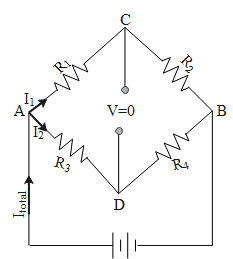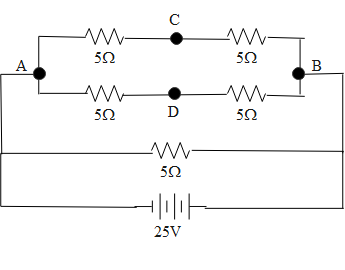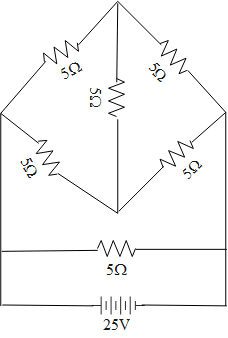
Answer
445.2k+ views
Hint: According to the ohms law the current flowing through a circuit is directly proportional to the voltage drop across the circuit. This proportionality is resolved by a proportionality constant R which represents the resistance of the circuit. The resistance is a linear property which remains constant in constant external conditions and depends on the internal factors such as area and the length of the material.
Complete step by step answer:
Wheatstone bridge is a circuit connection where 4 resistances are in rhombus type shape as shown in the circuit below,

The balance condition is when the ratio of resistance 1 and 2 is equal to the ratio of resistances 3 and 4 mathematically,
$\dfrac{{{R}_{1}}}{{{R}_{2}}}=\dfrac{{{R}_{3}}}{{{R}_{4}}}$
According to the principle of Wheatstone bridge, under balance conditions no current passes through the terminal C and D.
When we see the circuit given in the question we can conclude that one of the sections of the circuit is a balanced condition of Wheatstone bridge.
$\dfrac{5}{5}=\dfrac{5}{5}=1$
So, no current passes through the residence between terminals C and D.
The above circuit can be simplified as,

So the total resistance between points A and B is
$\frac{1}{R}=\frac{1}{{{R}_{1}}+{{R}_{3}}}+\frac{1}{{{R}_{2}}+{{R}_{4}}}$
This is because resistance in series is given by the algebraic sum of the resistance in series. Mathematically,
$R={{r}_{1}}+{{r}_{2}}+...$
So the resistance between the points A and B will be,
$\begin{align}
& \dfrac{1}{R}=\dfrac{1}{5+5}+\dfrac{1}{5+5} \\
& \Rightarrow R=\frac{10}{2} \\
& \Rightarrow R=5\Omega \\
\end{align}$
Terminal A and B are parallel to the resistance of \[5\Omega \]. So the total resistance of the circuit is given by
\[\begin{align}
& \frac{1}{{{R}_{total}}}=\dfrac{1}{5}+\dfrac{1}{5} \\
& \Rightarrow {{R}_{total}}=\dfrac{5}{2} \\
& \Rightarrow {{R}_{total}}=2.5\Omega \\
\end{align}\]
So the total resistance of the circuit is $2.5\Omega $
By using the application of the ohm's law we know that
$V=IR$
So, by rearranging the above equation,
$\begin{align}
& I=\dfrac{V}{R} \\
& \Rightarrow I=\dfrac{25}{2.5} \\
& \therefore I=10A \\
\end{align}$
So the total current flowing through the circuit is $10A$.
So, the correct answer is “Option A”.
Note: The Wheatstone bridge is named after the person who discovered it, Mr. Charles Wheatstone. It was formed to measure the value of some unknown resistance value and a means of calibrating measuring instruments such as voltmeters, ammeters, etc., by the use of long resistive slide wire. Wheatstone bridge is still used to measure the low value of resistance.
Complete step by step answer:
Wheatstone bridge is a circuit connection where 4 resistances are in rhombus type shape as shown in the circuit below,

The balance condition is when the ratio of resistance 1 and 2 is equal to the ratio of resistances 3 and 4 mathematically,
$\dfrac{{{R}_{1}}}{{{R}_{2}}}=\dfrac{{{R}_{3}}}{{{R}_{4}}}$
According to the principle of Wheatstone bridge, under balance conditions no current passes through the terminal C and D.
When we see the circuit given in the question we can conclude that one of the sections of the circuit is a balanced condition of Wheatstone bridge.
$\dfrac{5}{5}=\dfrac{5}{5}=1$
So, no current passes through the residence between terminals C and D.
The above circuit can be simplified as,

So the total resistance between points A and B is
$\frac{1}{R}=\frac{1}{{{R}_{1}}+{{R}_{3}}}+\frac{1}{{{R}_{2}}+{{R}_{4}}}$
This is because resistance in series is given by the algebraic sum of the resistance in series. Mathematically,
$R={{r}_{1}}+{{r}_{2}}+...$
So the resistance between the points A and B will be,
$\begin{align}
& \dfrac{1}{R}=\dfrac{1}{5+5}+\dfrac{1}{5+5} \\
& \Rightarrow R=\frac{10}{2} \\
& \Rightarrow R=5\Omega \\
\end{align}$
Terminal A and B are parallel to the resistance of \[5\Omega \]. So the total resistance of the circuit is given by
\[\begin{align}
& \frac{1}{{{R}_{total}}}=\dfrac{1}{5}+\dfrac{1}{5} \\
& \Rightarrow {{R}_{total}}=\dfrac{5}{2} \\
& \Rightarrow {{R}_{total}}=2.5\Omega \\
\end{align}\]
So the total resistance of the circuit is $2.5\Omega $
By using the application of the ohm's law we know that
$V=IR$
So, by rearranging the above equation,
$\begin{align}
& I=\dfrac{V}{R} \\
& \Rightarrow I=\dfrac{25}{2.5} \\
& \therefore I=10A \\
\end{align}$
So the total current flowing through the circuit is $10A$.
So, the correct answer is “Option A”.
Note: The Wheatstone bridge is named after the person who discovered it, Mr. Charles Wheatstone. It was formed to measure the value of some unknown resistance value and a means of calibrating measuring instruments such as voltmeters, ammeters, etc., by the use of long resistive slide wire. Wheatstone bridge is still used to measure the low value of resistance.
Recently Updated Pages
10 Examples of Evaporation in Daily Life with Explanations

10 Examples of Diffusion in Everyday Life

1 g of dry green algae absorb 47 times 10 3 moles of class 11 chemistry CBSE

What is the meaning of celestial class 10 social science CBSE

What causes groundwater depletion How can it be re class 10 chemistry CBSE

Under which different types can the following changes class 10 physics CBSE

Trending doubts
Fill the blanks with the suitable prepositions 1 The class 9 english CBSE

Which are the Top 10 Largest Countries of the World?

How do you graph the function fx 4x class 9 maths CBSE

Who was the leader of the Bolshevik Party A Leon Trotsky class 9 social science CBSE

The Equation xxx + 2 is Satisfied when x is Equal to Class 10 Maths

Differentiate between homogeneous and heterogeneous class 12 chemistry CBSE

Difference between Prokaryotic cell and Eukaryotic class 11 biology CBSE

Which is the largest saltwater lake in India A Chilika class 8 social science CBSE

Ghatikas during the period of Satavahanas were aHospitals class 6 social science CBSE





